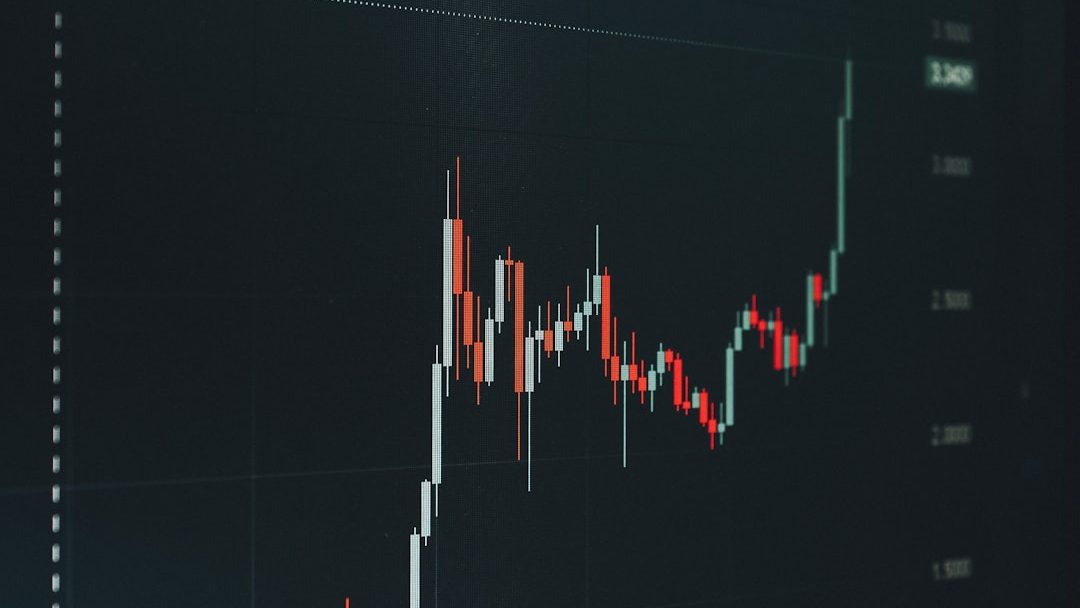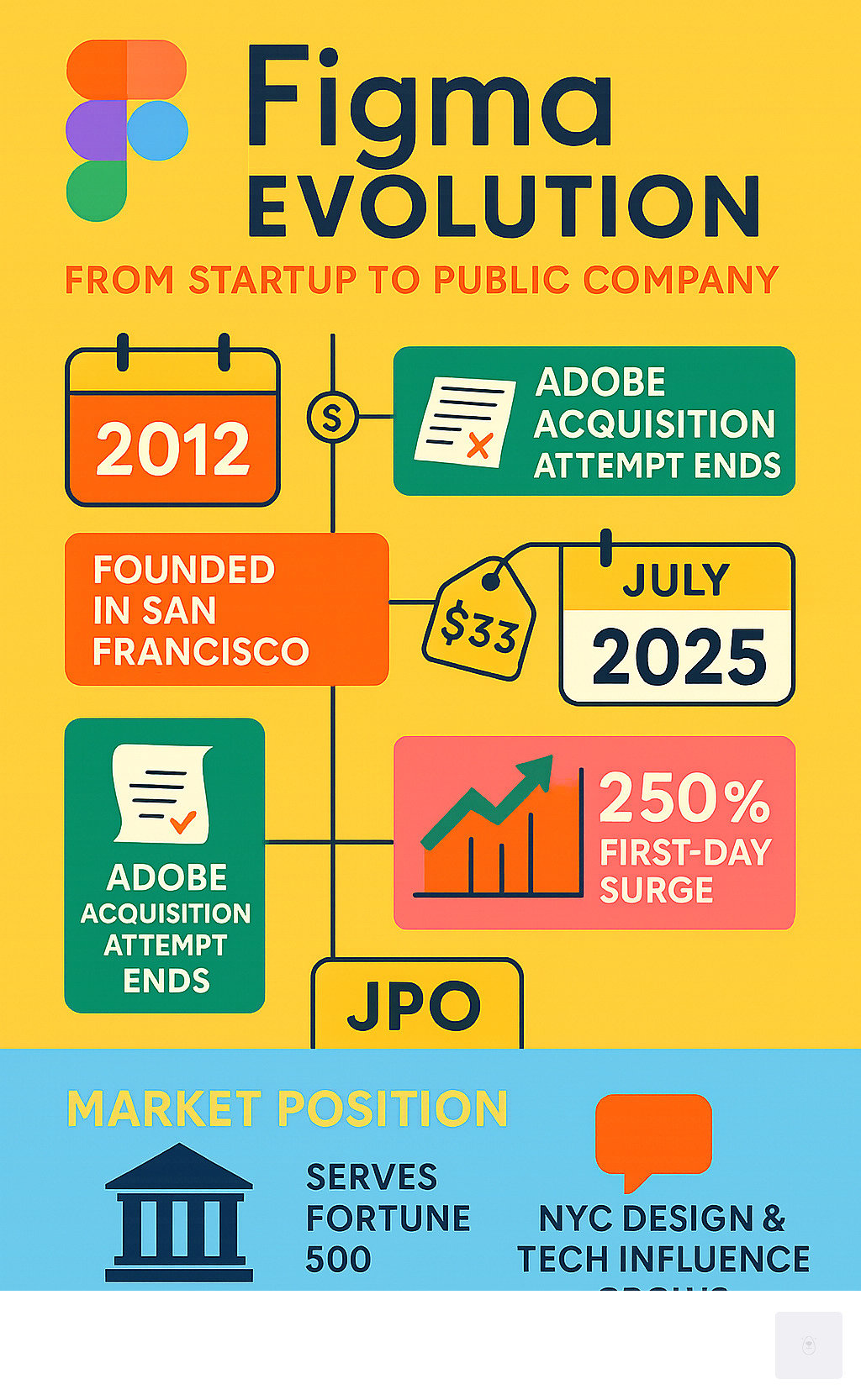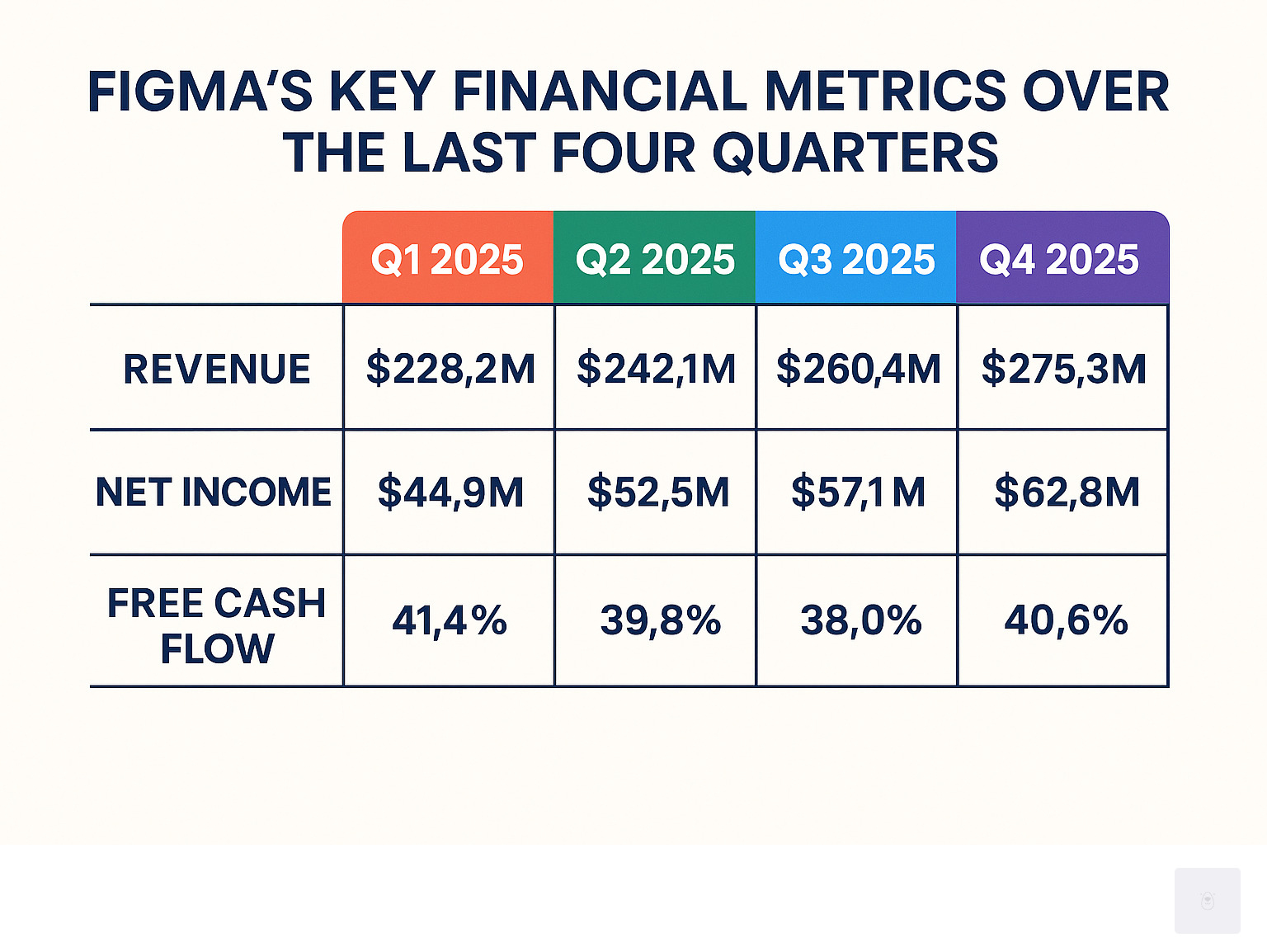
Why Figma Stock is Capturing Wall Street’s Attention
Figma stock has become one of the most talked-about investment opportunities in the tech sector, especially among New York City’s sophisticated investment community. Here’s what you need to know:
Key Figma Stock Facts:
- Ticker Symbol: FIG (NYSE)
- IPO Price: $33 per share (July 2025)
- First-Day Performance: Surged 250% to close at $115.50
- Current Valuation: Approximately $34-68 billion market cap
- Revenue Growth: 46% year-over-year in Q1 2025
- Business Model: SaaS-based collaborative design platform
The design software company’s public debut created quite the spectacle on Wall Street, with its IPO being 40x oversubscribed and generating significant buzz among institutional investors. However, the stock has experienced considerable volatility since its launch, dropping as much as 35% in some two-week periods before recovering.
Figma operates as the leading collaborative design platform, serving 13 million monthly active users and 95% of Fortune 500 companies. The company generates revenue through subscription tiers ranging from individual users to enterprise clients, with annual recurring revenue reaching $912 million.
As someone who has spent over 40 years observing New York’s financial and cultural elite, I’ve witnessed how transformative technologies capture the imagination of sophisticated investors. My experience covering major market events and analyzing investment trends through Figma stock and similar high-profile offerings provides unique insight into what makes certain IPOs resonate with discerning portfolios.

Figma stock word roundup:
Understanding Figma’s Business Model and Market Position
When I first started following Figma stock, what struck me most was how brilliantly simple their approach is. Founded in 2012, Figma transformed from a scrappy design tool into something much bigger – a connected, AI-powered platform that takes teams from that first spark of an idea all the way to a finished digital product.
What makes Figma special isn’t just the technology. It’s the collaboration. Picture this: instead of designers working in isolation, then throwing their work over the wall to developers, everyone works together in real-time. It’s like having the entire creative team in the same room, even when they’re scattered across different time zones.
I’ve watched this change happen right here in New York City. From the busy startups in Silicon Alley to the established Fortune 500 companies in Midtown, Figma stock investors are betting on a platform that’s become absolutely essential to how modern businesses create digital experiences.

What Drives Figma’s Revenue?
Figma’s money-making strategy is refreshingly straightforward – it’s built on that reliable Software-as-a-Service model that investors love. Think of it like a gym membership, but for design tools. Customers pay monthly or yearly subscriptions to access Figma’s platform, creating that predictable revenue stream that makes Figma stock so appealing to Wall Street.
The genius lies in their subscription tiers. Whether you’re a freelance designer working from a Brooklyn coffee shop or running design for a major Manhattan corporation, there’s a plan that fits. This isn’t accidental – it’s a carefully crafted strategy to capture everyone from individual creators to massive enterprise clients.
But here’s where it gets really smart: Figma grows through what they call product-led growth. Instead of aggressive sales tactics, the platform is so intuitive and collaborative that it spreads naturally within organizations. One designer starts using it, their teammates see the magic happen, and suddenly the whole company is hooked.
The Figma Design Platform Ecosystem includes everything teams need – collaborative design tools, prototyping features, brainstorming boards with FigJam, and even newer additions like Figma Slides. Once you’re in, you’re really in. For businesses serious about their digital strategy, this integrated approach is invaluable – something we often discuss when helping clients with branding services.
Figma’s Leadership in Collaborative Design
The numbers tell an incredible story about Figma’s market presence. We’re talking about 13 million monthly active users – that’s more people than live in all five boroughs of New York City. Even more impressive? 95% of Fortune 500 companies use Figma. From Netflix to Uber to Duolingo, the biggest names in business rely on this platform.
What I find fascinating about Figma’s success is their community engagement. They’ve built something that goes beyond just software – it’s a thriving ecosystem where designers share templates, developers contribute plugins, and product managers exchange best practices. This community doesn’t just use Figma; they actively make it better.
The real breakthrough is how Figma enables seamless designer-developer collaboration. Anyone who’s worked in tech knows the old frustration – beautiful designs that were impossible to build, or developers guessing what designers actually meant. Figma bridges that gap completely.
I’ve seen this change with prominent New York City businesses. Teams that used to spend weeks going back and forth between design and development now ship products in days. In a market as competitive as New York, that kind of speed matters. It’s why smart investors are paying attention to Figma stock – they’re not just buying into a design tool, they’re investing in the future of how digital products get made.
The Volatile Journey of Figma Stock (FIG)
If you’ve ever watched a Broadway show unfold with dramatic plot twists, you’ll understand what it’s been like following Figma stock (FIG) since its public debut. The journey has been nothing short of theatrical, complete with soaring highs and stomach-dropping lows that have kept Wall Street analysts and New York City investors glued to their screens.
When Figma finally made its grand entrance on the New York Stock Exchange, it wasn’t just another tech IPO – it was the event that everyone in our financial circles had been waiting for. After years of speculation and anticipation, the company’s stock market debut delivered drama worthy of a prime-time financial thriller.
Analyzing the Initial Figma Stock Performance
Picture this: Figma stock opened for trading at what seemed like a reasonable $33 per share. But what happened next was pure Wall Street magic – or madness, depending on your perspective. The stock didn’t just rise; it absolutely rocketed to close at $115.50 on its first day. That’s a jaw-dropping 250% surge that had investors doing double-takes at their portfolios.
The excitement didn’t stop there. During that wild first day of trading, Figma stock actually peaked at $124.63, pushing the company’s valuation to nearly $68 billion. I’ve covered many high-profile events in my decades observing New York’s elite, and the energy around this initial public offering was absolutely electric.
The numbers tell an incredible story of demand. The IPO was 40 times oversubscribed, meaning investors wanted far more shares than were available. This kind of frenzy is rare, even in New York’s sophisticated investment community where we’ve seen it all.
But here’s where the story gets interesting – and a bit sobering. After that spectacular opening act, reality set in. Figma stock experienced the kind of volatility that makes even seasoned investors reach for their antacids. The stock tumbled 34.9% between August 1st and August 15th, and at one point crashed 23% right after its NYSE debut. Another sharp drop saw it fall 27% as investors took profits from those early gains.
This rollercoaster wasn’t entirely unexpected. Analyst reactions ranged from cautious optimism to outright skepticism about whether the stock’s premium valuation made sense. Trading volumes swung wildly as investor sentiment shifted from pure euphoria to a more measured “let’s see what happens next” approach.
Factors Influencing Figma Stock Price Movements
Understanding what drives Figma stock movements requires looking at the bigger picture – something we’ve learned to do well here in New York’s financial district. Several key factors have been pulling the strings behind these dramatic price swings.
The broader tech market trends play a huge role in how Figma performs. When the entire tech sector catches a cold, individual stocks like Figma often get the sniffles too. We’ve seen this pattern repeatedly with high-growth companies, where market sentiment can shift quickly based on overall economic conditions.
The interest rate environment has been particularly influential. When rates rise, investors tend to favor stable, profitable companies over high-growth stocks with lofty valuations. It’s simple math – higher interest rates make those future earnings less valuable today, which impacts how investors price growth companies like Figma.
Then there’s the lock-up period expiration factor. These are agreements that prevent company insiders from selling their shares immediately after an IPO, typically for 90 to 180 days. When these restrictions lift, it can flood the market with new shares, creating downward pressure on the stock price.
For anyone following the latest developments, keeping tabs on Figma, Inc. (FIG) Latest Stock News & Headlines – Yahoo Finance provides real-time insights into what’s moving the stock. The interplay of these factors creates a dynamic environment that keeps Figma stock anything but boring.
Financial Health and Valuation: A Deep Dive
When it comes to Figma stock, the real story lies beneath the surface excitement of its IPO debut. As someone who’s spent decades analyzing investment opportunities for New York’s most discerning investors, I’ve learned that sustainable wealth comes from understanding the numbers behind the hype.

Let’s start with the encouraging news. Figma’s revenue growth has been genuinely impressive, with 2024 total revenue jumping 48% to $749 million. The momentum continued into 2025, with first-quarter sales climbing 46% year-over-year to $228.2 million. While we’re seeing a slight deceleration in growth rate, this is natural for maturing companies and still represents robust expansion.
The profitability picture tells an interesting story. Yes, Figma reported a substantial $732 million net loss in the previous year, but here’s the key detail – most of that was due to stock compensation expenses. When we look at more recent performance, first-quarter 2025 net income was $0.04 per share, with net income actually tripling to $44.9 million. That’s a dramatic turnaround that caught many Wall Street analysts by surprise.
What really excites me as someone who’s watched countless companies rise and fall is Figma’s free cash flow. In Q1 2025, free cash flow equaled 41.4% of total revenue. This means the company is converting nearly half of its revenue into actual cash – a sign of operational excellence that would make any CFO in Manhattan proud. Add to this a completely debt-free balance sheet and a $1.5 billion cash cushion, and you have a company with serious financial flexibility.
Is Figma Overvalued?
Here’s where things get complicated, and frankly, where many New York investors are having heated debates over cocktails at their favorite Upper East Side haunts. Figma stock is trading at valuations that would make even the most optimistic growth investor pause.
The price-to-sales ratio sits between 41 to 47 times sales. To put this in perspective, most software companies trade at 10 to 20 times sales. The price-to-earnings ratio? A jaw-dropping 496 times annualized first-quarter earnings. These numbers suggest that investors are betting everything on Figma’s ability to maintain extraordinary growth for years to come.
The reality is that Figma stock shareholders could face significant losses if the company’s revenue growth decelerates faster than expected. While it’s not impossible for a software business to grow into such steep valuations, it’s certainly not common. The company itself expects its growth rate to decline as it matures, making the timing and magnitude of this deceleration critical for investors.
Recent financial highlights from Q1 2025 paint a mixed but generally positive picture: Revenue reached $228.2 million (up 46%), while Annual Recurring Revenue hit $912 million. Net income tripled to $44.9 million, and the company maintained its zero debt status with $1.5 billion in cash. The customer base grew to 450,000, with 47% growth in high-value clients – particularly encouraging for enterprise strategy. Gross margins remained healthy at 88.50%, though overall profit margins reflected previous year losses at -85.40%. Most impressively, earnings per share increased 231.80% quarter-over-quarter.
Key Financials to Watch
For anyone considering Figma stock in their portfolio, certain metrics deserve your constant attention. Annual Recurring Revenue of $912 million demonstrates strong subscription momentum – exactly what you want to see in a SaaS business model. This predictable revenue stream is why many institutional investors in New York find software companies so appealing.
Customer growth tells an equally compelling story. With 450,000 total customers and 47% growth in high-value clients, Figma is successfully moving upmarket to enterprise accounts. These larger contracts typically offer better margins and longer retention rates, creating a more stable revenue foundation.
The company’s ability to maintain its impressive free cash flow generation will be crucial as it steers the inevitable growth deceleration ahead. This metric, more than any flashy revenue number, will determine whether Figma stock can justify its premium valuation in the years to come.
Future Outlook: Growth, AI Integration, and Potential Risks
Looking ahead, Figma stock presents a fascinating study in contrasts – tremendous potential wrapped in genuine uncertainty. After decades of watching companies rise and fall in New York’s dynamic business landscape, I’ve learned that the most interesting investment stories often involve companies standing at the crossroads of innovation and risk.

The Role of Artificial Intelligence in Figma’s Future
Figma isn’t content to rest on its collaborative design laurels. The company is boldly changing itself into an AI-powered platform, and frankly, it’s about time. The integration of artificial intelligence into design workflows could be as as when Figma first introduced real-time collaboration.
The company’s “Figma Make” feature represents this exciting shift – an AI tool that can design and prompt functional prototypes. Early projections suggest this single feature could generate an additional $100 million by 2027. That’s not just impressive; it’s potentially game-changing for the stock’s trajectory.
What makes this AI strategy particularly compelling is how it could automate routine design tasks while freeing up creative minds for higher-level thinking. Generative AI features are already showing promise in speeding up workflows and opening entirely new creative possibilities. For design teams across Manhattan’s tech corridors, this could mean the difference between keeping pace and leading the pack.
But here’s where it gets interesting – and a bit unsettling. The same AI that could cement Figma’s competitive advantage also poses an existential question. What happens when AI becomes so sophisticated that it can handle complex design tasks independently, requiring perhaps just one human to review the output? It’s a scenario that forward-thinking investors, especially those involved in strategic planning services, are already contemplating.
Challenges and Headwinds for Investors
Despite its AI ambitions and impressive growth story, Figma stock faces some sobering realities that would make even the most optimistic Wall Street analyst pause.
The high valuation concern remains the elephant in the room. Trading at 41 to 47 times sales and nearly 500 times earnings, Figma has virtually no margin for error. Any stumble – a missed quarter, slower growth, or market hiccup – could trigger a sharp correction that would make those early post-IPO drops look gentle by comparison.
Sustaining hyper-growth becomes exponentially harder as companies mature. While 46% year-over-year revenue growth is enviable, maintaining such momentum is like trying to accelerate a sports car that’s already going 100 mph. Figma has already captured 78% of Forbes 2000 companies – a remarkable achievement that also highlights a challenge. The low-hanging fruit has been picked. Future growth must come from deeper client penetration, expanding into smaller businesses, or launching entirely new product lines.
The specter of market saturation looms particularly large. When you’ve already won over nearly four-fifths of the world’s largest companies, where do you go next? It’s a luxurious problem to have, but a real one nonetheless.
Finally, macroeconomic factors could throw a wrench into even the best-laid plans. Rising interest rates, economic slowdowns, or shifts in corporate spending priorities could impact software budgets across the board. For a company with Figma’s premium valuation, even small changes in growth expectations could have outsized effects on the stock price.
The path forward for Figma stock is neither guaranteed nor impossible – it’s simply uncertain, which makes it both thrilling and nerve-wracking for investors willing to take the ride.
Frequently Asked Questions about Figma’s Stock
As someone who’s spent decades navigating the intersection of Wall Street and high society here in New York, I find myself fielding quite a few questions about Figma stock at cocktail parties and charity galas. Whether it’s over champagne at the Met or during a quiet moment at Lincoln Center, the conversation inevitably turns to this fascinating tech darling. Let me share the most common questions I hear from our sophisticated New York audience.
How does Figma make money?
This is always the first question from practical investors, and rightfully so. Figma operates on what we call a Software-as-a-Service (SaaS) model – think of it like a subscription to your favorite magazine, but for design software. The company generates revenue primarily through tiered subscription plans for its collaborative design platform.
These subscriptions aren’t one-size-fits-all. Figma has crafted specific offerings for individuals, teams, and large enterprises, ensuring there’s something for everyone from the solo freelancer working out of a Brooklyn co-working space to the massive Fortune 500 companies headquartered right here in Manhattan. The beauty of this model is that customers pay a recurring fee to access Figma’s suite of tools, which includes Figma Design, FigJam, Dev Mode, and their emerging AI-powered features like Figma Make.
This recurring revenue structure provides predictable cash flow – something that makes investors sleep better at night, especially in uncertain times.
Was Figma’s IPO considered a success?
Oh, what a day that was! Yes, despite the post-IPO rollercoaster that followed, Figma’s debut was widely considered a major success by Wall Street standards. I remember the buzz among New York City investors – it was palpable.
The numbers tell the story beautifully. Figma stock was priced at a modest $33 per share, but by the closing bell, it had soared to $115.50 – that’s a 250% gain in a single day! The IPO was 40 times oversubscribed, meaning there was incredible demand from investors eager to get in on the action.
This spectacular performance reinvigorated the tech IPO market, especially here in New York where we’d been hungry for a blockbuster tech offering. While the stock did experience significant pullbacks in the weeks that followed – as is often the case with high-flying debuts – that initial performance was undoubtedly a triumph that captured Wall Street’s attention and reminded everyone why tech IPOs can be so exciting.
What are the biggest risks associated with investing in Figma?
This question usually comes up during the more serious conversations, often after the second glass of wine when people really want to understand what they’re getting into. The risks with Figma stock are quite real and multifaceted.
The most immediate concern is valuation – and this is a big one. With price-to-sales ratios significantly above industry averages, Figma is trading at what many consider a premium price. This means the market has very high expectations, and there’s little room for disappointment. Any stumble could lead to a sharp correction.
Then there’s the growth sustainability challenge. Maintaining rapid growth becomes increasingly difficult as companies mature. Figma has already captured an impressive portion of large enterprises, so future growth will need to come from deeper penetration or entirely new markets.
Perhaps most intriguingly, there’s the long-term AI disruption risk. While Figma is integrating AI into its offerings, there’s always the possibility that artificial intelligence could eventually automate the very design tasks that make Figma indispensable today. It’s a fascinating paradox – the technology that could improve their platform might also, someday, threaten its very existence.
For those of us who’ve watched markets evolve over decades, these risks remind us that even the most promising investments require careful consideration and a clear understanding of what we’re signing up for.
Conclusion: Is Figma a Buy for Your Portfolio?
After diving deep into Figma stock, one thing becomes crystal clear: this isn’t your typical investment decision. It’s a company that has genuinely revolutionized how design teams work together, and its story reads like a modern Silicon Valley fairy tale – complete with dramatic plot twists.
The investment thesis for Figma is built on solid ground. The company dominates collaborative design like few others dominate their markets. With 95% of Fortune 500 companies already using their platform, Figma has proven it can attract and retain the world’s most demanding clients. Their long-term potential looks promising, especially with AI integration that could transform design workflows in ways we’re only beginning to imagine.
From a financial standpoint, Figma checks many boxes that savvy investors look for. Zero debt, robust free cash flow equal to 41% of revenue, and a $1.5 billion cash cushion provide impressive financial stability. The company’s SaaS model delivers predictable recurring revenue, which any investor can appreciate.
But here’s where things get interesting – and frankly, a bit nerve-wracking. The risk assessment for Figma stock reads like a cautionary tale about sky-high valuations. Trading at 41 to 47 times sales and nearly 500 times earnings, this stock is priced for absolute perfection. One stumble, one quarter of disappointing growth, and investors could face substantial losses.
For our discerning New York City audience, who understand both opportunity and risk, this presents a classic high-stakes scenario. The company must maintain breakneck growth rates while navigating market saturation among large enterprises. Plus, there’s the fascinating paradox of AI – it could either boost Figma’s growth or eventually threaten its core business model.
The importance of due diligence cannot be overstated here. This isn’t a stock you buy on a whim or because everyone’s talking about it at Manhattan cocktail parties. It requires careful consideration of your risk tolerance and investment timeline. Can you handle the volatility? Are you betting on Figma’s ability to grow into its premium valuation?
From our New York perspective, we’ve seen countless high-flying tech stocks capture Wall Street’s imagination, only to disappoint when reality sets in. Yet we’ve also witnessed companies that seemed impossibly valued eventually justify every penny through sustained innovation and growth.
Figma stock represents both the promise and peril of investing in transformative technology companies. While we at R. Couri Hay Columns focus on society and culture commentary, we recognize that smart investment decisions require the same careful analysis we bring to understanding complex social dynamics.
Whether Figma belongs in your portfolio depends entirely on your individual circumstances and appetite for risk. What we can say with certainty is that this company’s journey will be fascinating to watch unfold, and we’ll continue providing our unique insights into its evolution. For more information on how we illuminate complex topics with clarity and insight, explore our publicity services.


